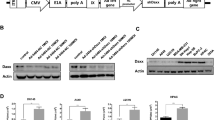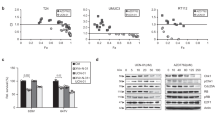Abstract
Oncolytic virotherapy with conditionally replicating viruses is a promising approach for treating advanced cancers. Promiscuous tropism and low tumor transduction have represented limiting issues, which targeting approaches seek to overcome. An approach utilizing a secretory targeting molecule for the epidermal growth factor pathway (sCAR-EGF) has previously been shown to be compatible with replicating adenoviruses, when an E1-deleted vector was used in a dual-virus system in conjunction with a replication-competent agent. Here, we constructed a virus that replicates in cancer cells and codes for sCAR-EGF. Interestingly, the oncolytic potency of the novel agent was not improved over nontargeted controls in vitro or in vivo. These results suggest that the expression of biologically active proteins can be counterproductive to virus replication.
This is a preview of subscription content, access via your institution
Access options
Subscribe to this journal
Receive 12 print issues and online access
$259.00 per year
only $21.58 per issue
Buy this article
- Purchase on Springer Link
- Instant access to full article PDF
Prices may be subject to local taxes which are calculated during checkout




Similar content being viewed by others
References
Hemminki A, Alvarez RD . Adenoviruses in oncology: a viable option? BioDrugs. 2002;16:77–87.
Dmitriev I, Kashentseva E, Rogers BE, Krasnykh V, Curiel DT . Ectodomain of coxsackievirus and adenovirus receptor genetically fused to epidermal growth factor mediates adenovirus targeting to epidermal growth factor receptor-positive cells. J Virol. 2000;74:6875–6884.
Hemminki A, Dmitriev I, Liu B, et al. Targeting oncolytic adenoviral agents to the epidermal growth factor pathway with a secretory fusion molecule. Cancer Res. 2001;61:6377–6381.
Kolibaba KS, Druker BJ . Protein tyrosine kinases and cancer. Biochim Biophys Acta. 1997;1333:F217–F248.
Fueyo J, Gomez-Manzano C, Alemany R, et al. A mutant oncolytic adenovirus targeting the Rb pathway produces anti-glioma effect in vivo. Oncogene. 2000;19:2–12.
Bauerschmitz GJ, Lam JT, Kanerva A, et al. Treatment of ovarian cancer with a tropism modified oncolytic adenovirus. Cancer Res. 2002;62:1266–1270.
Kanerva A, Wang M, Bauerschmitz GJ, et al. Gene transfer to ovarian cancer versus normal tissues with fiber-modified adenoviruses. Mol Ther. 2002;5:695–704.
Loimas S, Wahlfors J, Janne J . Herpes simplex virus thymidine kinase-green fluorescent protein fusion gene: new tool for gene transfer studies and gene therapy. Biotechniques. 1998;24:614–618.
Wildner O, Morris JC, Vahanian NN, et al. Adenoviral vectors capable of replication improve the efficacy of HSVtk/GCV suicide gene therapy of cancer. Gene Therapy. 1999;6:57–62.
Hawkins LK, Johnson L, Bauzon M, et al. Gene delivery from the E3 region of replicating human adenovirus: evaluation of the 6.7 K/gp19 K region. Gene Therapy. 2001;8:1123–1131.
Russell WC . Update on adenovirus and its vectors. J Gen Virol. 2000;81:2573–2604.
Sherr CJ . Cancer cell cycles. Science. 1996;274:1672–1677.
Busse D, Doughty RS, Ramsey TT, et al. Reversible G(1) arrest induced by inhibition of the epidermal growth factor receptor tyrosine kinase requires up-regulation of p27(KIP1) independent of MAPK activity. J Biol Chem. 2000;275:6987–6995.
Kang SS, Wang L, Kao WW, Reinach PS, Lu L, et al. Control of SV-40 transformed RCE cell proliferation by growth-factor-induced cell cycle progression. Curr Eye Res. 2001;23:397–405.
Ravitz MJ, Yan S, Dolce C, Kinniburgh AJ, Wenner CE, et al. Differential regulation of p27 and cyclin D1 by TGF-beta and EGF in C3H 10T1/2 mouse fibroblasts. J Cell Physiol. 1996;168:510–520.
Vinogradova O, Carlin C, Sonnichsen FD, Sanders II CR . A membrane setting for the sorting motifs present in the adenovirus E3-13.7 protein which down-regulates the epidermal growth factor receptor. J Biol Chem. 1998;273:17343–17350.
Prudenziati M, Sirito M, van Dam H, Ravazzolo R . Adenovirus E1A down-regulates the EGF receptor via repression of its promoter. Int J Cancer. 2000;88:943–948.
Boulukos KE, Ziff EB . Adenovirus 5 E1A proteins disrupt the neuronal phenotype and growth factor responsiveness of PC12 cells by a conserved region 1-dependent mechanism. Oncogene. 1993;8:237–248.
Tollefson AE, Stewart AR, Yei SP, Saha SK, Wold WS . The 10,400- and 14,500-dalton proteins encoded by region E3 of adenovirus form a complex and function together to down-regulate the epidermal growth factor receptor. J Virol. 1991;65:3095–3105.
Carlin CR, Tollefson AE, Brady HA, Hoffman BL, Wold WS . Epidermal growth factor receptor is down-regulated by a 10,400 MW protein encoded by the E3 region of adenovirus. Cell. 1989;57:135–144.
Kashentseva EA, Seki T, Curiel DT, Dmitriev IP . Adenovirus targeting to c-erbB-2 oncoprotein by single-chain antibody fused to trimeric form of adenovirus receptor ectodomain. Cancer Res. 2002;62:609–616.
Kim J, Idamakanti N, et al. Targeting adenoviral vectors by using the extracellular domain of the coxsackie-adenovirus receptor: improved potency via trimerization. J Virol. 2002;76:1892–1903.
Hemminki A, Kanerva A, Liu B, et al. Modulation of coxsackie-adenovirus receptor expression for increased adenoviral transgene expression. Cancer Res 2003;63:847–853.
Acknowledgements
We thank Dr Bin Liu for help with virus production. This study was supported by the Sigrid Juselius Foundation, Emil Aaltonen Foundation, Maud Kuistila Foundation, Finnish Medical Foundation, Finnish Cancer Society, Biocentrum Helsinki, Lustgarten Foundation, Susan G Komen Foundation, the NCI (RO1 CA83821, P50 CA83591, P50 CA89019 R01 CA94084) and the University of Helsinki internal funds.
Author information
Authors and Affiliations
Corresponding author
Rights and permissions
About this article
Cite this article
Hemminki, A., Wang, M., Hakkarainen, T. et al. Production of an EGFR targeting molecule from a conditionally replicating adenovirus impairs its oncolytic potential. Cancer Gene Ther 10, 583–588 (2003). https://doi.org/10.1038/sj.cgt.7700606
Received:
Published:
Issue Date:
DOI: https://doi.org/10.1038/sj.cgt.7700606
Keywords
This article is cited by
-
Barriers to systemic application of virus-based vectors in gene therapy: lessons from adenovirus type 5
Virus Genes (2017)
-
Bispecific Adapter-Mediated Retargeting of a Receptor-Restricted HSV-1 Vector to CEA-Bearing Tumor Cells
Molecular Therapy (2011)
-
Armed replicating adenoviruses for cancer virotherapy
Cancer Gene Therapy (2009)
-
Recent developments in the use of adenoviruses and immunotoxins in cancer gene therapy
Cancer Gene Therapy (2007)
-
Luciferase imaging for evaluation of oncolytic adenovirus replication in vivo
Gene Therapy (2007)



